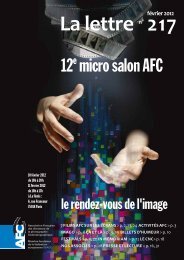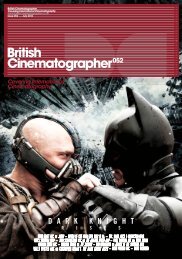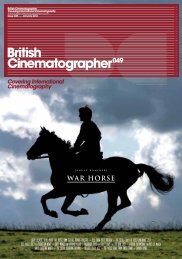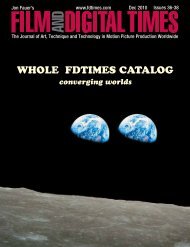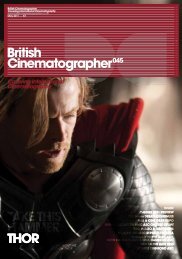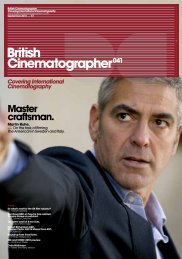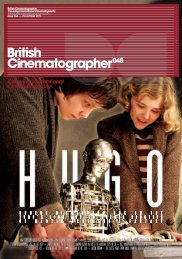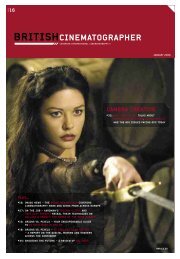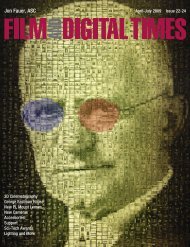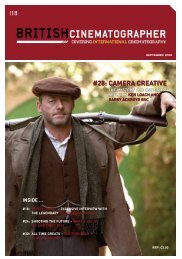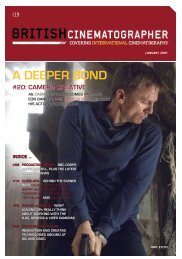British Cinematographer issue 51 - Imago
British Cinematographer issue 51 - Imago
British Cinematographer issue 51 - Imago
You also want an ePaper? Increase the reach of your titles
YUMPU automatically turns print PDFs into web optimized ePapers that Google loves.
<strong>British</strong> <strong>Cinematographer</strong><br />
Covering International Cinematography<br />
www.britishcinematographer.co.uk<br />
Issue 0<strong>51</strong> ––– May 2012 20<br />
21<br />
<strong>British</strong> <strong>Cinematographer</strong><br />
Covering International Cinematography<br />
www.britishcinematographer.co.uk<br />
Issue 0<strong>51</strong> ––– May 2012<br />
Close-Up<br />
–––Greig Fraser ACS<br />
Snow White And The Huntsman<br />
Australian <strong>Cinematographer</strong> Greig Fraser was in Jordan<br />
shooting Zero Dark Thirty with Kathryn Bigelow when<br />
<strong>British</strong> <strong>Cinematographer</strong> finally tracked him down.<br />
However, we wanted to transport him out the desert, and<br />
the grim nature of that film, back to the fantastic world of<br />
his previous project, the dark fairy tale Snow White And<br />
The Huntsman.<br />
Greig Fraser whose previous feature credits include<br />
Let Me In (2011) and Bright Star (2009) joined renowned<br />
commercials director Rupert Sanders, who was making<br />
his feature film debut with Universal’s Snow White<br />
And The Huntsman. Starring Kristen Stewart and Chris<br />
Hemsworth in the title roles and Charlize Theron as the<br />
evil queen, it’s a new take on the traditional story of<br />
jealousy, love and dark magic.<br />
“I was involved relatively early on, around nine<br />
months before we started shooting,” recalls Fraser. “So I<br />
was able to start working with Rupert then, drawing on<br />
references and coming up with the way that the film<br />
would feel and look. It’s a fairytale, so there’s a number<br />
of different ways you can shoot this type of story. We<br />
just wanted to make sure that we were being relatively<br />
unique in what we were doing - and that we were doing<br />
something that we would want to see.”<br />
The creative references included thousands of<br />
images “from a whole range of photographers”, from<br />
painters like Caravaggio to installation artists, to singers.<br />
“We drew inspiration from songs and the way<br />
things sound,” Fraser says. “As for films, we drew from<br />
some how we wanted to do interior lighting, and from<br />
other films we took how we wanted to do camera<br />
movements, while for others it was how to do battle<br />
scenes. We were quite wide and varied in what we did.”<br />
Fraser started his full-time pre-production about ten<br />
weeks before shooting began on Snow White And The<br />
Huntsman, at Pinewood Studios in August 2011. “I would<br />
spend that time going on location scouts, referencing,<br />
meeting with actors, doing tests, looking at tests, testing<br />
digital versus film, and looking at blow-ups of all that,”<br />
he explains. The production’s many enchanted forest<br />
scenes were filmed out in the parklands near the studio,<br />
with woodland locations being augmented by specially<br />
constructed exterior sets.<br />
“We had nature surrounding us, but our production<br />
designer John Watkins built some speciality forests within<br />
those forests,” explains Fraser. “That was a deliberate<br />
decision as the director and I wanted to work with a<br />
certain level of ‘lack of control’. When you build a forest<br />
in a studio you have to light it and so automatically it<br />
looks like a studio and it looks controlled.”<br />
Sanders and Fraser had a close working relationship.<br />
“We’d talk about shots and we’d do shot lists and<br />
storyboard occasionally together, but we also wanted<br />
to allow ourselves to find our way a little bit on the<br />
day,” reveals Fraser. “Working this way means more<br />
often than not you’re finding yourself faced with happy<br />
accidents. We were dealing with wonderful actors in<br />
Chris Hemsworth, Kristen Stewart and Charlize Theron,<br />
who were all very open to ‘finding the scene’ when we<br />
were in it.”<br />
“We were lucky with the weather,” admits Fraser. “We<br />
started shooting in August and did all the bright sunny<br />
enchanted forest stuff early. We shot the dark forest midway<br />
through October and before it got too dark.”<br />
The cinematographer was, of course, able to call<br />
upon technical equipment and expertise to tame<br />
extremes of lighting and shade. “We had built a really<br />
big forest, so we still had <strong>issue</strong>s with the sun getting in<br />
where we didn’t want it. We tried to schedule shooting<br />
in such a way that wide shots were filmed before the sun<br />
came up too high and also used coverage.”<br />
“My gaffer Perry Evans had a couple of 40’x40’ flyswatters<br />
(cloth grids hanging from construction cranes)<br />
which we flew over the set, and those 40x40 solids could<br />
block a lot of the direct sun. So when it was sunny we<br />
lost a lot of the direct sun and when it was overcast we<br />
could use those as negative fill. It meant we were really<br />
able to sculpt the light. But it was definitely a challenge.<br />
It was probably more difficult to shoot in the exterior<br />
than it would have been easier to use interiors, but the<br />
results for us were a lot more appropriate for what we<br />
were aiming for.”<br />
That quest for an appropriate look encompassed<br />
the choice of format - Fraser shot most of his sequences<br />
on 35mm anamorphic film, using Kodak 5201, 5207 and<br />
5230 stock. 65mm film was also used on the movie.<br />
“Each film has its own decisions you make when<br />
you choose a format and we tested a number,” Fraser<br />
explains. “We were very impressed with the Alexa and<br />
RED Epic. They were really great. But we found that<br />
35mm anamorphic film still had a depth and a resolving<br />
power that the digital formats didn’t have. It had a<br />
depth of colour that we responded to really well.”<br />
“The film and the set dressing was going to be very<br />
colourful and we didn’t feel the digital formats really did<br />
justice to the colour that we were going to use in the<br />
piece,” he continues. “We felt at that time that film was<br />
most appropriate for that story as well. We were dealing<br />
with a medieval story, we were dealing with a lot of<br />
firelight, just things that we decided film was better for<br />
than digital at the moment.”<br />
This is not to say that Fraser is against digital formats<br />
by any means. “In Jordan we’re shooting on the ARRI<br />
Alexa M and it is 100 percent the right decision for the<br />
film I’m doing right now. It’s still in testing mode and is<br />
a very nice piece of equipment. But on Snow White...<br />
anamorphic film just has a timeless, fantastic look to it.<br />
And as for the Kodak stock, I just love it.”<br />
On Sanders’ film, Fraser’s choice of camera was the<br />
Panavision Panaflex Millennium XL shooting at an aspect<br />
ratio of 2.35:1 with Panavision G-Series Lenses. This is a<br />
Panavision-built and -rented set of lenses, which the DP<br />
has used on two films in a row. “You learn the nuances<br />
of lenses when you use them more often,” he explains.<br />
“You learn where the best resolving power is, where the<br />
best focus is. The G-Series is a really nice sweet lens.”<br />
Fraser has a particular favourite in the set. “It’s a<br />
very fast anamorphic 50mm lens which has great focus<br />
fall off and it has a very interesting distortion of areas<br />
on the edge of frame. We used that a lot in the dark<br />
forest. In particular there’s a sequence where Snow<br />
White breathes magic mushrooms. She becomes a little<br />
bit spacey, so I used that lens a lot for that sequence.<br />
It has a hard-to-describe quality; it almost looks like a<br />
shift-and-tilt. There are a couple of scenes where the<br />
Queen is becoming a little bit psychotic so we also used<br />
it there too. It helps differentiate the actor out from the<br />
background, just helps bring them out and creates a<br />
very unearthly feel.”<br />
Fraser would often be at Sanders’ side in the video<br />
village, discussing and controlling the lighting and the<br />
shots. “We had fantastic operators, George Richmond<br />
on the A camera and Simon Baker on the B camera,” he<br />
explains. “George is also a steadicam operator, so we<br />
had access to that and used it a number of times. We<br />
also had a 44ft Moviebird on set and when on location<br />
we’d use a 50ft Technicrane.”<br />
Occasionally Fraser would get on a camera for more<br />
intimate shots with just the director and actors. “That was<br />
something that Rupert and I had planned from day one<br />
– that there would be a few key scenes in there that we<br />
were treating more intimately. So there was a successful<br />
balance of small crews and bigger crew.”<br />
“My major concerns on the production were that we<br />
were achieving on film what we set out to achieve and<br />
that we were maximising the subject material visually<br />
and narratively,” he concludes. “We had to be properly<br />
documenting the drama, that was my ultimate goal.”



